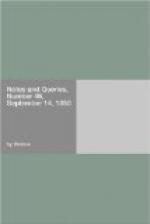“The persons now privileged to wear the ancient golden collar of SS. are the equites aurati, or knights (chevaliers) in the British monarchy, a body which includes all the hereditary order of baronets in England, Scotland, and Ireland, with such of their eldest sons, being of age, as choose to claim inauguration as knights.”
Here we have a full confession of a large part of the faith of the Baronets’ Committee,—a committee of which the greater number of those who lent their names to it are probably by this time heartily ashamed. It is the doctrine held forth in several works on the Baronetage compiled by a person calling himself “Sir Richard Broun,” of whom we read in Dodd’s Baronetage, that “previous to succeeding his father, he demanded inauguration as a knight, in the capacity of a baronet’s eldest son; but the Lord Chamberlain having refused to present him to the Queen for that purpose, he assumed the title of ‘Sir,’ and the addition of ‘Eques Auratus,’ in June, 1842.” So we see that ARMIGER and the Lord Chamberlain are at variance as to part of the law above cited; and so, it might be added, have been other legal authorities, to the privileges asserted by the mouthpiece of the said committee. But that is a long story, on which I do not intend here to enter. I had not forgotten that in one of the publications of Sir Richard Broun the armorial coat of the premier baronet of each division is represented encircled with a Collar of Esses; but I should never have thought of alluding to this freak, except as an amusing instance of fantastic assumption. I will now confine myself to what has appeared in the pages of “NOTES AND QUERIES;” and, more particularly, to the unfounded assertion of ARMIGER in p. 194., “that the golden Collar of SS. was the undoubted badge or mark of a knight, eques auratus;” which he follows up by the dictum already quoted, that “the persons now privileged to wear the ancient golden Collar of SS. are the equites aurati.” I believe it is generally admitted that knights were equites aurati because they wore golden or gilt spurs; certainly it was not because they wore golden collars, as ARMIGER seems to wish us to believe; and the best proof that the Collar of Esses was not the badge of a knight, as such, at the time when such collars were most worn, in the fifteenth century, is this—that the monumental effigies and sepulchral brasses of many knights at that time are still extant which have no Collar of Esses; whilst the Collar of Esses appears only on the figures of a limited number, who were undoubtedly such as wished to profess their especial adherence to the royal House of Lancaster.
JOHN GOUGH NICHOLS.
* * * * *
SIR GREGORY HORTON, BART.
(Vol. ii., p. 216.)
The creation of the baronetcy of Norton, of Rotherfield, in East Tysted, co. Hants, took place in the person of Sir Richard Norton, of Rotherfield, Kt., 23d May, 1622, and expired with him on his death without male issue in 1652.




